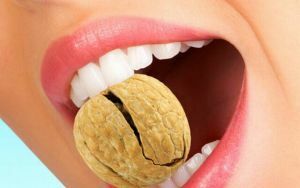 A tooth is a bone formation in the oral cavity, which can rightfully be called an organ. Due to its special structure, the teeth perform the most important function - the mechanical processing of food, they have a developed blood and nervous system.
A tooth is a bone formation in the oral cavity, which can rightfully be called an organ. Due to its special structure, the teeth perform the most important function - the mechanical processing of food, they have a developed blood and nervous system.
But, like any organ, the tooth is often "sick."And this is not always known to everyone caries. One of the most common defects in dentistry is considered to be cracks in the enamel of the teeth.
They are often overlooked, and this leads to unpleasant consequences, which could be avoided with timely access to the dentist.
Contents of
- What is commonly called a tooth crack?
- About the causes of tooth decay
- What are the cracks and where are they localized?
- Necessary assistance
- Prevention of destruction
What is commonly called a tooth rift?
A split or incomplete fracture is a rupture of the enamel with or without involvement in the pathological process of dentin. In this case, the tooth remains whole, still and resistant to loosening.
This defect sometimes has the form of microcracks, which are detected only when examined by a dentist. Deeper cracks are clearly visible, they can pigment from consumed food or drinks( tea, coffee) and become even more pronounced.
If the crack is small, it rarely delivers discomfort and its presence is not even guessed. But any small defect with time begins to increase in size, as the mechanical load on the surface of the tooth remains the same. 
Also, the appearance of tooth cleavage is affected by temperature changes. Larger and longer-term cracks can make themselves felt by a number of symptoms:
- pain that does not have a clear localization;
- discomfort or pain when closing and opening jaws during chewing;
- high sensitivity to sudden changes in temperature of consumed food.
Pain syndrome occurs due to a violation of the integrity of the first two layers - enamel and dentin, when chewing their sharp fragments cut into the pulp and cause pain.
If the problem is not solved for a long time, the pain becomes chronic, since the person's jaws work constantly. Damage to the pulp can cause swelling of soft gum tissue, the formation of periodontal pockets, an unpleasant taste in the mouth, a smell from the mouth and darkening of the enamel.
Large cracks pass into the tissues of the tooth the remains of food, this causes the development of the inflammatory process, as the protective barrier is broken and nutrients contribute to the development of pathogenic microflora.
If the dentin is damaged in addition to the enamel, then the inflammation passes to the pulp, in this case we have to talk about the removal of the tooth.
About the causes of tooth decay
The appearance of cracks may have a mechanical or physiological character. In the first case, the appearance of a defect is associated with excessive force on the tooth:
- injury( fall, bruises, etc.);
- regular use of solid food;
- cracking of nuts, opening bottles, etc.;
- bad habits( gnawing pen, pencil, etc.);
- bruxism( grinding teeth in a dream);
- improper treatment at the dentist( incorrect selection of tools, installation of an excessively large pin, etc.);
- incorrect bite.
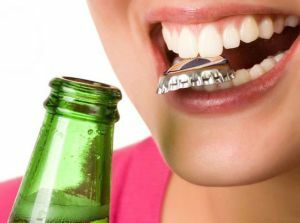 In case of mechanical damage, concomitant pathologies are possible - bruising, dislocation, fracture of the tooth.
In case of mechanical damage, concomitant pathologies are possible - bruising, dislocation, fracture of the tooth.
Physiological causes are often associated with processes that occur inside the tissues of the tooth during eating food with a sharply differing temperature( take a hot dish with cold compote, ice cream with coffee).
This is due to the fact that as the temperature increases, the enamel expands much faster and more than the dentin, and when cooled, its volume decreases and an obstacle is felt on the dentin side, which leads to the appearance of enamel-dentine stress and, as a consequence, to the crack.
Work in places with high temperature( hot shops) leads to overheating of bone tissue and is also a risk factor for the formation of cracks. In addition, smoking, taking certain drugs and a diet that does not contain the necessary supply of trace elements and vitamins can also cause such defects.
What are the cracks and where are they located?
Cracks can form completely on any part of the tooth. It happens that the damage affects the crown or its root, and sometimes both parts at the same time. Most often, a crack begins to form from a fine grid of splits, and eventually lengthens and expands.
The lower jaw suffers most of all, because it is on it that the greatest mechanical pressure is. Teeth with large fillings and without pulp are considered weaker, therefore, cracks are formed in them first.
The defect may be on the front, inside or through the entire fabric. Sometimes cracks appear inside or between the teeth, then to detect them is very difficult and almost impossible even to the dentist.
Depending on the location of the crack, there may be: 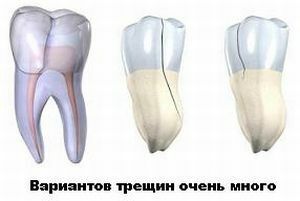
- vertical;
- horizontal;
- is inclined.
Vertical cracks begin on the crown and extend along it to the root. Sometimes the process itself affects the root itself.
In this case, it is often necessary to remove the tooth, as the pulp is damaged. Horizontal and inclined cracks always lead to a fracture. However, with this arrangement of the defect, the probability of developing pulpitis and tooth loss is minimal.
Necessary help for
If a crack is found, immediately contact the dentist, limiting to the maximum all mechanical effects on the patient's tooth before visiting a specialist. Self-cure and get rid of the tooth fracture is not possible.
Before starting treatment, the doctor examines the oral cavity and sends the patient to x-ray imaging, if there is any doubt about the diagnosis, then the endodontic doctor is available. Depending on the depth, size, location, nature and causes of the crack, several options for ongoing therapy are possible.
So, what can be done if there are cracks in the teeth:
- Remineralization .A set of procedures aimed at restoring the enamel. The patient is prescribed to lubricate teeth with a gel, which
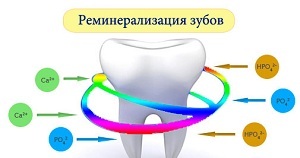 is rich in fluorine, phosphorus and calcium. Its use leads to the strengthening of enamel. After that, the cracks are filled with a special composite, which hardens from the radiation of a special lamp. This varnish protects the tooth for a short time - about six months, after which the patient again needs to carry out a similar procedure. It is expensive, but very effective with minor damages.
is rich in fluorine, phosphorus and calcium. Its use leads to the strengthening of enamel. After that, the cracks are filled with a special composite, which hardens from the radiation of a special lamp. This varnish protects the tooth for a short time - about six months, after which the patient again needs to carry out a similar procedure. It is expensive, but very effective with minor damages. - Installation of veneers .Veneers are thin ceramic plates that are worn on teeth with injuries( usually the front ones).They correct the cosmetic defect, protect against mechanical damage and prevent the penetration of pathogens. Veneers are created individually according to the shape and color of the patient's tooth, so they are absolutely invisible in the oral cavity.
- Crown fixing .In case the crack was formed on the chewing tubercle and did not affect the pulp, the part of the tooth is removed and the crown is restored from above. If the pulp was damaged, then its nerves are removed, the root canals are sealed and the crown is placed on top for protection.
- Removing the tooth .If the pathological process is started, the fissure passes through all the tissues, the pulp is damaged, the inflammation passed to the gum and the injured tooth can not be saved, then a decision is made to remove it.
After treatment of a defect, a lot depends not only on the dentist, but also on the patient. It is very important not to aggravate the state of dental health and comply with the rules of prevention of crack formation.
What can be done if the front tooth cracked:
destruction prevention To avoid splitting or not to cause the appearance of new defects, it is enough to perform a number of simple rules:
- observe the rules of oral hygiene;
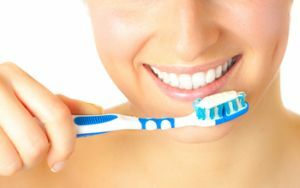
- use toothpastes without bleaching effect;
- use toothpastes containing calcium and fluoride;
- do not eat foods at the same time with a sharp difference in temperature;
- not bite hard objects( nuts, pen, pencil, etc.);
- limit the number of sweets and carbonated drinks in the diet;
- to quit smoking;
- adhere to proper nutrition;
- seek help from highly qualified dentists.
By following these instructions you can save a healthy and beautiful smile for a long time and significantly reduce material costs, as dental treatment is an expensive pleasure.
Cracks in the teeth - this is not only an aesthetic defect, but also pathology that carries a danger to human health. If you leave them unattended and do not go to the doctor, the result will be discomfort, pain, inflammation, and maybe a tooth loss.
Attention to the condition of the oral cavity is an opportunity to keep healthy strong teeth as long as possible and not become a regular client of a dentist.
